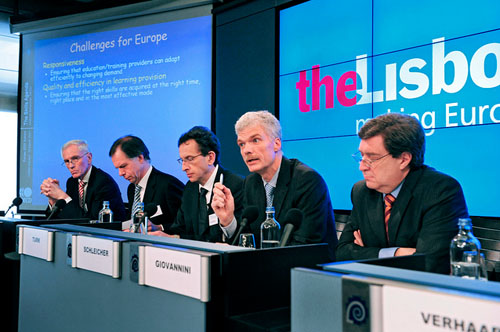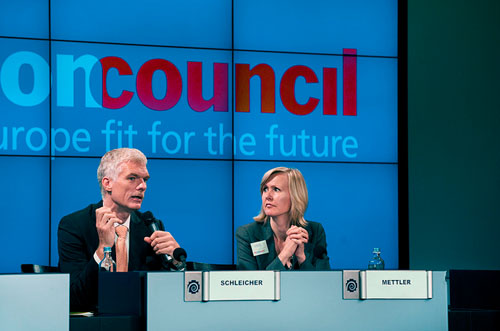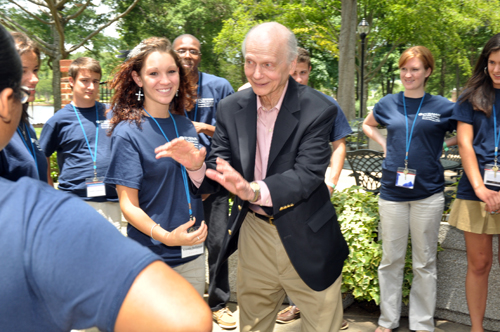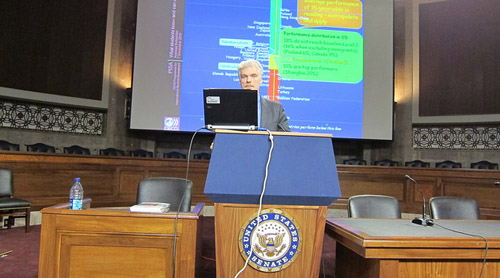
According to Andreas Schleicher of OECD, the United States is unique among countries in that the generation of workers entering the US workforce does not have higher college attainment levels than the generation about to leave the workforce. He further believes a key strategy to addressing this problem is improving equitable access to education across the board and that good examples of how to achieve this can be found in other education systems such as Finland, Kanada, Japan or Korea. None of this sounds particularly new, aber ich fragte mich, ob Andreas wurde die große Bild Bildungsentscheidungen, wie würde er auf einige der wichtigsten Fragen? We recently had the opportunity to discuss this further.
Andreas Schleicher ist Sonderberater für Bildungspolitik der OECD-Generalsekretärs, und ist stellvertretende Direktorin für Bildung. Er liefert strategischen Aufsicht über Arbeiten der OECD über die Entwicklung und Nutzung von Fähigkeiten und ihrer sozialen und wirtschaftlichen Ergebnissen. Dazu gehört auch die PISA-Studien (PISA), the OECD Survey of Adult Skills (PIAAC), the OECD Teaching and Learning International Survey (GREAT), and the development and analysis of benchmarks on the performance of education systems (INES).

Should government provide tuition free education from pre-school through college?
There is no free education; someone has to pay. If governments provide free education from pre-school through college, they need to back that up with a steeply progressive tax system so that the better qualified people end up paying the bill eventually. The Nordic countries in Europe show that this can work, and work well. The other good option is to ask students to pay tuition and to back that up with a universal student support system that provides an income-contingent loan system complemented with a scheme of means-tested grants. In that way you minimize risks for students, avoid that they end up with huge debt that they cannot pay back, and you provide special assistance to those students who would otherwise be prevented from attending university. The UK shows how this can work. Providing college tuition-free without getting the money back through taxes for the better-educated means that the poor end up subsidizing the education of the rich.
Are you in favor of privatizing public schools?
Results from PISA show no performance advantage of private schools, once you account for social background. Jedoch, cross-country analysis of PISA suggests that the prevalence of schools’ autonomy to define and elaborate their curricula and assessments relates positively to the performance of school systems, even after accounting for national income. School systems that provide schools with greater discretion in deciding student assessment policies, the courses offered, the course content and the textbooks used are also school systems that perform at higher levels. So perhaps the question for countries is not how many private or charter schools they have, but how they enable every public school to assume charter-type responsibility.

Since every child is probably not meant to pursue a liberal arts education, what would you do to make our children more competitive in the skilled trade jobs market?
Our data show that when employers are involved in designing curricula and delivering education programs at the post-secondary level, students seem to have a smoother transition from education into the labor market. Compared to purely government-designed curricula taught in school-based systems, learning in the workplace offers several advantages: it allows trainees to develop “hard” skills on modern equipment, und “soft” Fähigkeiten, such as teamwork, communication and negotiation, through real-world experience. Hands-on workplace training can also help to motivate disengaged youth to stay in or re-engage with the education system. Workplace training also facilitates recruitment by allowing employers and potential employees to get to know each other, while trainees contribute to the output of the training firm. Workplace learning opportunities are also a direct expression of employers’ Bedürfnisse, als Arbeitgeber bereit sein, Chancen in Bereichen anbieten zu können, wo es einen Mangel an Fachkräften.

Glauben Sie, dass die Vereinigten Staaten muss mehr im Bereich der frühkindlichen Bildung zu tun, und wenn ja,, was denn?
Einerseits, die USA fällt weit hinter den meisten Ländern in der industrialisierten Welt, wenn es um die frühkindliche Bildung kommt, und das ist zweifellos ein wichtiger Hebel, um Qualität und Gerechtigkeit in Lernergebnisse zu erhöhen. Gleichzeitig, the US does really well when you look at student performance in primary education, so-so when it comes to performance in middle school, and not very well when it comes to performance in high school. This suggests that students actually get quite a strong start, but the school system adds less year after year than what children in other countries learn. That is something you don’t address with better early childhood education but with a better school system.
What do you think is the best way to fund our public schools?
The US spends plenty of money on public schools, but our data show three things. Zunächst, a disproportionally high share of that spending does not make it into the classroom. Zweitens, spending is regressive in that schools in disadvantaged areas end up with less resources than schools in socially advantaged areas (in virtually all other industrialized countries it is the other way around). This does not allow the US to attract the most talented teachers into the most challenging classrooms, which would make public spending most effective. Drittel, high performing countries tend to prioritize the quality of teachers and the size of classes. The trend in the US over the last decade has gone the other way around.

Photos courtesy of OECD.
In der globalen Suche nach Bildung, mit mir und weltweit renommierten Vordenkern wie Sir Michael Barber (Vereinigtes Königreich), DR. Michael Block (US-), DR. Leon Botstein (US-), Professor Ton Christensen (US-), DR. Linda Hammond-Liebling (US-), DR. Madhav Chavan (Indien), Professor Michael Fullan (Kanada), Professor Howard Gardner (US-), Professor Andy Hargreaves (US-), Professor Yvonne Hellman (Niederlande), Professor Kristin Helstad (Norwegen), Jean Hendrickson (US-), Professor Rose Hipkins (Neuseeland), Professor Cornelia Hoogland (Kanada), Herr Jeff Johnson (Kanada), Frau. Chantal Kaufmann (Belgien), DR. Eija Kauppinen (Finnland), Staatssekretär Tapio Kosunen (Finnland), Professor Dominique Lafontaine (Belgien), Professor Hugh Lauder (Vereinigtes Königreich), Professor Ben Levin (Kanada), Herr Ken Macdonald (Vereinigtes Königreich), Professor Barry McGaw (Australien), Shiv Nadar (Indien), Professor R. Natarajan (Indien), DR. PAK NG (Singapur), DR. Denise Papst (US), Sridhar Rajagopalan (Indien), DR. Diane Ravitch (US-), Richard Wilson Riley (US-), Sir Ken Robinson (Vereinigtes Königreich), Professor Pasi Sahlberg (Finnland), Andreas Schleicher (PISA, OECD), DR. Anthony Seldon (Vereinigtes Königreich), DR. David Shaffer (US-), DR. Kirsten Sivesind (Norwegen), Kanzler Stephen Spahn (US-), Yves Theze (Lycee Francais US-), Professor Charles Ungerleider (Kanada), Professor Tony Wagner (US-), Sir David Watson (Vereinigtes Königreich), Professor Dylan Wiliam (Vereinigtes Königreich), DR. Mark Wormald (Vereinigtes Königreich), Professor Theo Wubbels (Niederlande), Professor Michael Young (Vereinigtes Königreich), und Professor Zhang Minxuan (China) wie sie das große Bild Bildung Fragen, die alle Nationen heute konfrontiert erkunden. Die Global Search for Education Community-Seite
C. M. Rubin ist der Autor von zwei weit Lese Online-Serie für den sie eine 2011 Upton Sinclair Auszeichnung, “Die globale Suche nach Bildung” und “Wie werden wir gelesen?” Sie ist auch der Autor von drei Bestseller-Bücher, Inklusive The Real Alice im Wunderland.
Folgen Sie C. M. Rubin auf Twitter: www.twitter.com/@cmrubinworld






Jüngste Kommentare